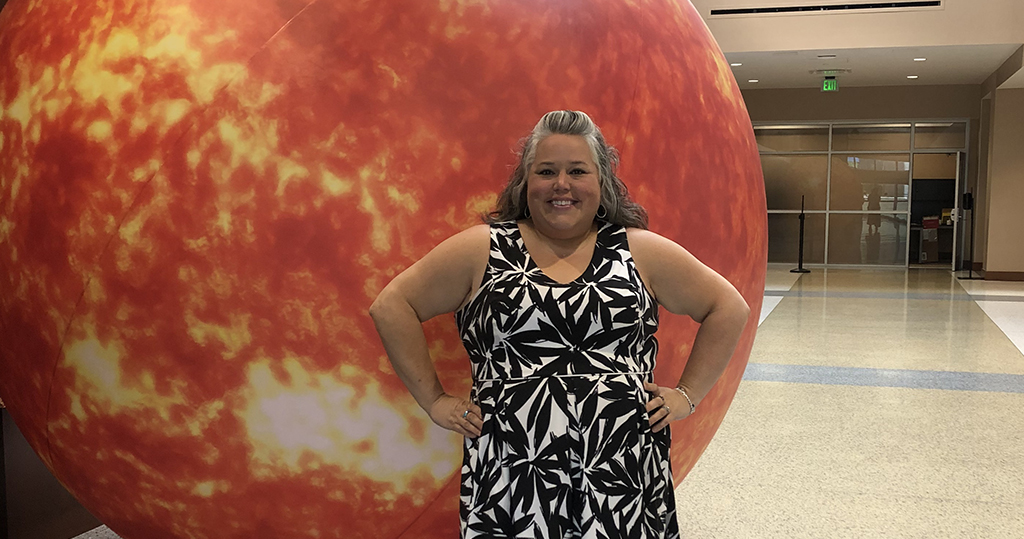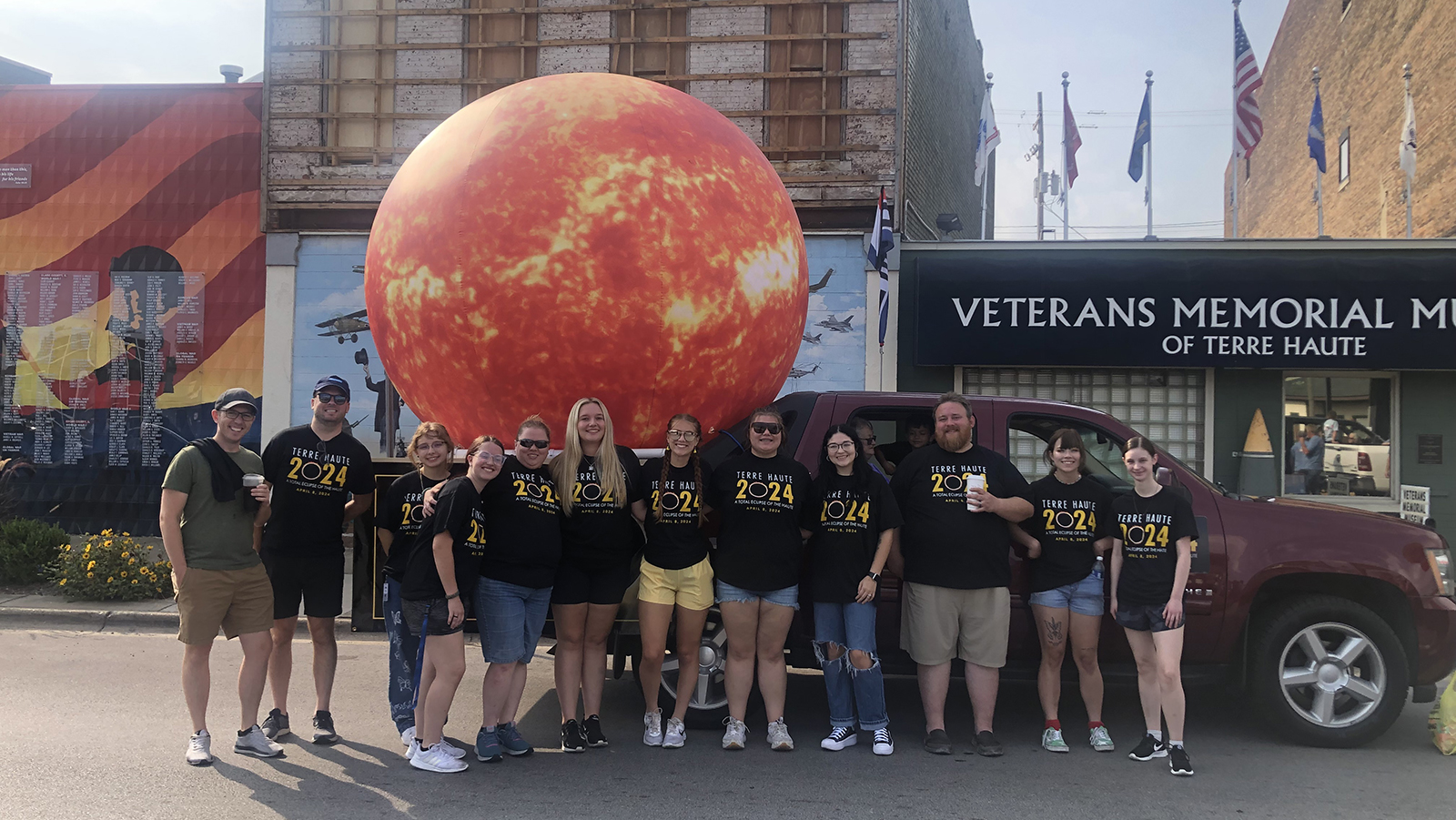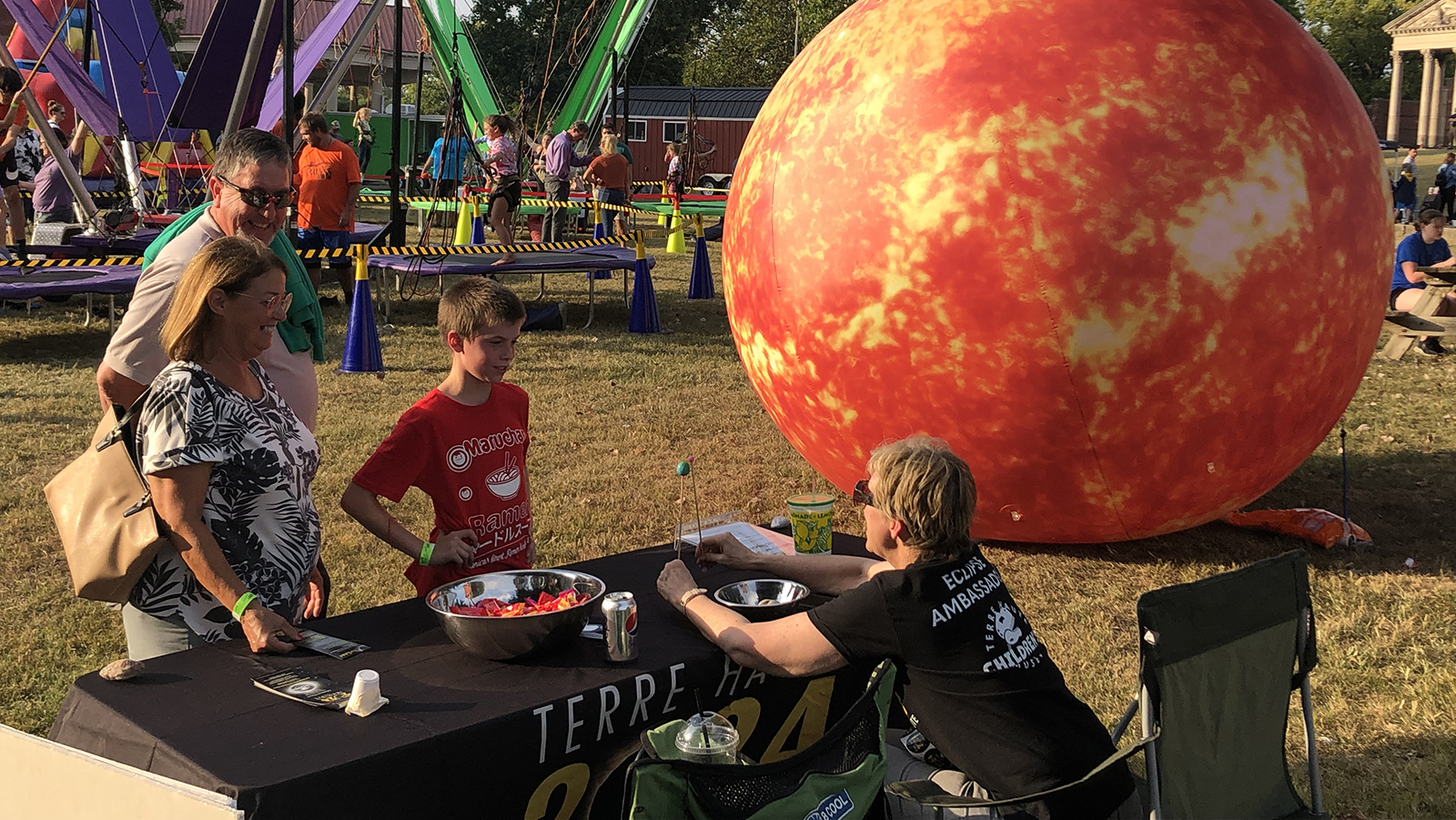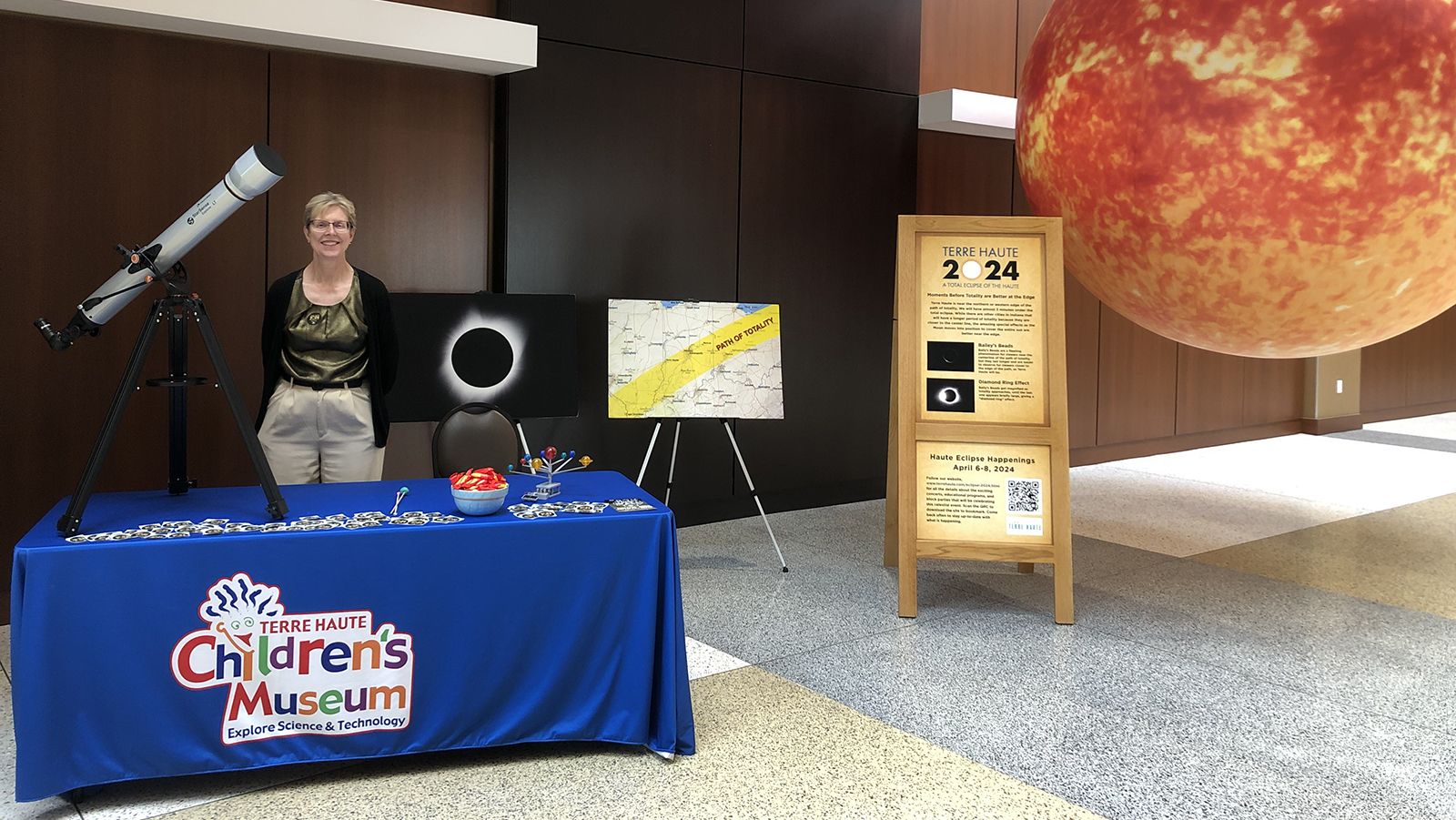
Interview: Susan Turner from the Terre Haute Children’s Museum
If you find yourself in Terre Haute, Indiana, you may encounter a 10-foot inflatable sun strapped to the back of a pickup truck with Susan Turner, executive director of the Terre Haute Children’s Museum (THCM), or her husband at the wheel. The inflatable sun is part of Turner and the museum’s plan to raise excitement in Terre Haute for the total solar eclipse passing through on April 8, the city’s first since 1869.
In her position as executive director, Turner plays many roles in helping prepare Terre Haute. She helped bring an eclipse-themed exhibit, titled “A Total Eclipse of the Haute,” to the museum (a playful nod to Bonnie Tyler’s hit “Total Eclipse of the Heart”). Beyond the museum’s walls, Turner and THCM are helping engage all of Terre Haute through the museum’s community ambassador program, which is preparing 30 local organizations to help excite and educate the public about the eclipse. Turner also leads a citywide task force for the cosmic event, addressing topics like marketing, public safety and tourism.
We recently spoke to Turner about her efforts in Terre Haute for the 2024 eclipse. The transcript below has been edited for clarity and brevity.
Hey, Susan, thanks for your time. Tell us a bit about yourself.
I’m the executive director of the Terre Haute Children’s Museum. I have been here for almost five years and got into the museum world after some time in marketing, economic development and higher education. I never thought I would be running a museum, but here I am!
What’s your favorite memory of the sun?
When my husband and I adopted our little boy, the sunset that we saw when we were driving to the hospital to meet our son for the first time was maybe the most beautiful sunset I’ve ever seen in my life. It was pretty spectacular and felt surreal.

That’s amazing. What has your relationship to science been throughout your life, and how did that end up leading you to where you are now?
I’ve always been interested in science. I was very fortunate growing up that my mom understood the importance of museums and exposing me to different cultural things. So I had lots of opportunities growing up. Now I’m married to a high school physics teacher, which leads to some pretty interesting conversations at our house. I’ve always been fascinated by science and all the cool things that are related to it.
In my current position, I think back to what I wanted to learn about when I was a little girl, and what I want my son to learn about as he’s growing up. He just turned 6, and he’s starting to really explore the world and all that’s available. So I think, What can we offer to him? What would be impactful to him as he’s developing his own little personality? I also want the museum to be not only a science center but a place that’s really fun, that builds community and helps solidify that family fun environment.
Can you tell us a bit more about the museum?
At THCM, we are here to engage children in the exploration of the world around them and to encourage them to play, because we believe in the importance of play to really explore science, technology, engineering and math. We have been in operation for 35 years, and we’ve been in our current location for 13 years, so a lot of people refer to us as the “new” children’s museum. We’re not new anymore, but we are kind of young in the children’s museum world. We’re located right in the heart of downtown Terre Haute, which has a population of about 60,000; the county is about 100,000. We’re a midsize city in the Midwest, but we are the big city in a very rural area. So, we’ve been trying really hard to partner with other community partners to get out of our building and to go to other nonprofits, other after-school programs, other community centers to do cool science stuff in their locations.
I think museums have a really important role in the life span of a person. I think that it’s our job to help supplement what’s happening inside schools. We really try to understand what those metrics are from an educational standpoint with the state, things that both Indiana and Illinois have put forward as priorities for children and learning, and we try to make sure that our exhibits are complementary to them. We want this to be kind of like sneaky learning. You’re here. You’re playing. You’re having a good time. But you’re also learning about how important it is to move your body and about farming techniques and about the eclipse. So we are definitely in tune with what’s happening in the education system and see our role as very complementary to that.
How did you find out about the eclipse?
I have to give a lot of credit to Renee Henry, who is the museum’s director of education. It is because of Renee that you and I are talking today. She came into my office in 2021 — she had just gotten off a call from the Indiana Space Grant Consortium, and they were talking about the eclipse in 2024. She came running into my office, and she said, “Susan, we have to get ready for the eclipse in 2024. We have to have programming, and we have to have an exhibit,” and we have to do this, and we have to do that. I was like, “Renee, I am trying to do payroll in 2021. This is not a priority for me” — because as you’ll recall, we were in the middle of a pandemic, and children’s museums specifically were really hurt hard by that because we had to close our doors and revenue streams. Then here Renee is talking about this eclipse that I have no concept of and that at the time felt far away. God bless her, she just kept after me.
So what came next? How are you preparing for the eclipse?
After talking with Renee, we went to lots of different community leaders. I told them about the eclipse, and I asked them if they would like to take on the planning of community-wide events, because somebody needed to. They all said, “No, we think you should do it.” So the children’s museum is actually leading the community-wide efforts in Terre Haute for the eclipse. We came up with “A Total Eclipse of the Haute” as the name of our campaign. We are using it on absolutely everything that we print. We’ve had a parody song made, which is really fun.
We are at the forefront of planning for the community. We’ve created a task force of, like, 60 individuals who are in different committees helping make plans for that weekend. We’ve got a marketing committee, a hospitality committee, a public safety committee, an events and education committee, and then a tourism committee. They meet on a regular basis to talk about making plans for this upcoming event. It’s been really great.

Can you speak about your role within the city task force working to create a unique experience for Terre Haute?
We are located about three hours south of Chicago, and Chicago is not in [the path of] totality. Some communities as far as 30 minutes away from us aren’t in totality. So we think that we’re going to get a big influx the day of or the night before. I keep telling people, “We need to be prepared. We need to make sure that our restaurants are on board, our coffee shops are on board, our state and local police, and that everybody understands what’s going on, and at what magnitude, because we want to put our best foot forward as a community.” When we talked to the ladies from Sweetwater, Tennessee, who were in a very similar position for the 2017 eclipse, they actually had people fall in love with their community and move [to Sweetwater]. Ultimately, I want to be able to provide a great opportunity and learning experience and memorable experience for the people who live here. Terre Haute is actually on the northwest border of totality, which is really cool, so we’ve got almost three minutes of totality and I’ve been told that we have a better chance of seeing Bailey’s Beads where we are. But I also want to make sure that we open up the door to Terre Haute to other people, so they can see how wonderful it is. And maybe they’ll decide this is where they want to live.
I also know that THCM established a community ambassador program. How has that gone?
We identified all 30 partners throughout Terre Haute, and they’ve received their training and most of the goodies they’re going to get. It was fun to be here to see the different types of organizations that came together. It’s a great way for us to kind of grow our own network and to build those relationships across our region. We were intentional about choosing organizations that are in Terre Haute and in surrounding counties.
We really focused on those individuals or those organizations that wouldn’t be receiving this information or these resources otherwise — and looked at how these potential relationships could help us in the future as a museum. And we were very intentional about leveraging our relationships. I’ve worked in this community for almost 20 years. And so I asked myself, Who do I know who’s in my phone that I can just text, and say, “Hey, there’s this really great opportunity. Would you like to partner with us?” Leveraging those relationships was really important in this process.
What are the coming months looking like for you all?
We are very excited to have our “Total Eclipse of the Haute” exhibit open. It’s a really immersive experience that talks all about the science of the eclipse, like “What is an eclipse? Why is it so special that it’s happening here in Terre Haute?” We haven’t had one in Terre Haute since 1869, and we’re not going to have another one in Indiana until 2099. So when I say it’s a once-in-a-lifetime opportunity for our community, I really mean it.
We’re also going to be partnering with the school corporation and going into all of the elementary schools, which is 18 elementary schools in our community, and doing an hour-long program for all of the K through fifth graders to get them ready for the eclipse. And then working with the ambassadors, we’re doing lots of parades right now. We have a giant 10-foot sun that we inflate and put in the bed of my husband’s truck and strap that baby down and take on the parade route. It’s really fun just trying to get the word out about the eclipse that’s coming, and how people can engage with it in a meaningful and fun way. From a community-wide perspective, we have a ton of events coming up, and we’re very fortunate that we have four higher education institutions within our community. They’re all leaning in pretty hard to the eclipse and are opening up their campuses to do parties in their planetariums in the months leading up to the eclipse.

What do you think April 8 will look like in Terre Haute?
For the day of the eclipse, there’ll be things happening all over the community. There’ll be a festival downtown. There will be things at Fairbanks Park, and we have a rowing team, so they’re thinking about doing a race that day. We have a nationally known bike course, and they’re going to do a special race that day. We also have a nationally known cross-country field, and they’re thinking about doing a race that day. We’re going to have things at our pioneer village, at our local city parks, the airport is doing a fly-in — so there are so many things going on in Terre Haute to celebrate the eclipse. It’s pretty exciting.
What are you looking forward to in the aftermath of the eclipse?
I’m in the relationship-building business. That’s what I do. I think every relationship that I build is a bridge that helps the museum and our community get stronger. And so if we can figure out more ways to collaborate, I am all in on that. It’s already started to happen, just from relationships that we formed with the ambassadors. So I think that having this breadth and depth of relationship-building during this once-in-a-lifetime event is pretty special.
What advice do you have for people who are organizing around the eclipse?
“Say yes to the opportunity.” I could have very easily said, “No, we’re not doing this. It’s too much. It’s too big.” Because it is a lot. I’m running a museum, but I’m also running the community-wide efforts to plan for who knows what’s coming, you know. But we all said yes, and the stars aligned. We have this great tagline with “Total Eclipse of the Haute,” and someone at the Simons Foundation noticed it. They reached out to us, and we met with them on a Sunday morning in December. By February we were standing on a street corner in New York City. My director of education said, “I don’t know how we can do this,” and I said to her, “I don’t know how we can not do this. No one else is gonna do this.” And I said to Renee, “I’m not going to make you do this. I want you to think about it. Go home, think about it, and we’ll talk about it when we go back to the office.” I knew I had her when she started emailing me in the middle of the night with ideas about what the ambassador program might look like. It’s just awesome that a pretty small science center has been given this opportunity.
Thank you for your time, Susan.
Thank you.